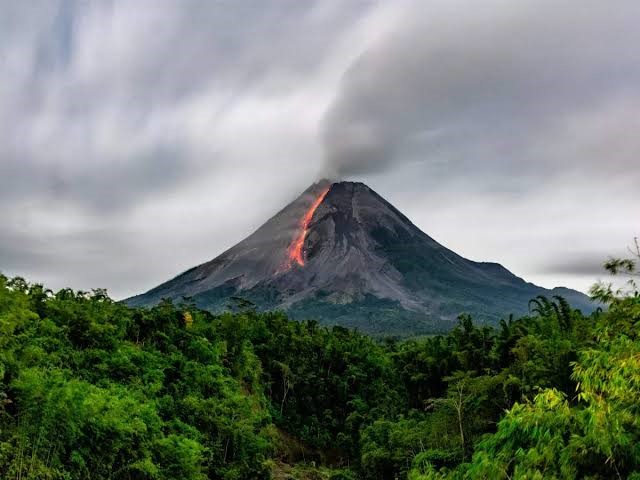
Mount Merapi

05.12.2023
Mount Merapi , Daily Current Affairs , RACE IAS : Best IAS Coaching in Lucknow
|
For Prelims: About Mount Merapi,Important points,About Pacific Ring of Fire,Categories of Volcanoes For mains paper:Reason for volcanic eruption,Types of Volcano |
Why in the news?
Recently, Mount Merapi in Indonesia's West Sumatra province erupted, spewing white and gray ash more than 3,000 meters (about 9,800 feet) into the air.
Important points:
- With over 60 eruptions since the late 18th century, Marapi claims to be the most active volcano in Sumatra.
- Merapi's last major eruption in 2010 killed 347 people.
- In December 2021, Mount Semeru, the highest volcano on Java island, erupted, killing 48 people and leaving 36 missing.
- There are approximately 130 active volcanoes in the Southeast Asian country.
About Mount Merapi:
- Mount Merapi is a conical volcano. It is located on the border between Central Java and Yogyakarta, Indonesia.
- Mount Merapi is called Gunung Merapi in Indonesian and Jawi languages.
- Mount Merapi is an active stratovolcano or mixed type volcano.
- Mount Marapi, meaning 'mountain of fire', is the most active volcano on the island of Sumatra (Indonesia).
- The volcano, 2,891 meters high, is at the third-highest alert level of Indonesia's four-tier system and authorities have imposed an exclusion zone around the Marapi crater.
- Marapi has been active since January when it erupted without any casualties.
- It is one of more than 120 active volcanoes in Indonesia that are at risk of seismic upheaval due to its location on the Pacific "Ring of Fire", an arc of volcanoes and fault lines that encircle the Pacific Basin.
- The Indonesian archipelago lies on the Pacific Ring of Fire, where the meeting of continental plates causes high volcanic and seismic activity.
About Pacific Ring of Fire:
- It is also known as the Circum-Pacific Belt.
- It is a passage along the Pacific Ocean with active volcanoes and frequent earthquakes.
- Its length is approximately 40,000 kilometers (24,900 mi).
- It traces the boundaries between several tectonic plates – including the Pacific, Juan de Fuca, Cocos, Indian-Australian, Nazca, North American, and Philippine plates.
About Volcano:
- A volcano is a crack or mouth present on the earth's surface from which hot lava, gas, ash etc. from inside the earth come out.
- In fact, it is a fracture in the upper layer of the earth through which the substances inside come out.
- The conical landform formed by the accumulation of these substances released by the volcano is called a volcanic cone.
- Volcanoes are related to plate tectonics because it has been found that they are often found along the boundaries of plates because plate boundaries provide weak places for fractures to occur in the upper layer of the earth.
- Apart from this, volcanoes are also found at some other places whose origin is believed to be from the mantle plume and such places are called hotspots.
- In geomorphology, volcanism is seen as a sudden phenomenon.
Reason for volcanic eruption:
- Volcanic eruptions begin with the formation of magma in the lower part of the Earth's crust.
- The Earth's crust is made up of huge slabs called plates, which fit together like a puzzle.
- The friction that occurs during the movement of plates causes earthquakes and volcanic eruptions.
Types of Volcano:
- Cinder Cones: These are the simplest type of volcano. They occur when particles and drops of lava flow out of a volcanic vent. Lava quickly flies into the air, and fragments rain down around the vent.
- Mixed Volcano: It is also called stratovolcano. These are symmetrical cones of large dimensions composed of alternating layers of lava flows, steep-sided, volcanic ash, blocks, bombs and cinders
- Shield Volcano: It is usually composed almost entirely of liquid lava flows. Their slopes are very gentle and they develop horizontally. Shield volcanoes are formed by intense eruptions that flow in all directions. Violent eruptions of this volcano are negligible.
- Lava Dome: Unlike composite and shield volcanoes, lava domes are small in size. They are formed when lava becomes too sticky to travel very far.
Categories of Volcanoes:
On the basis of activity, volcanoes are divided into three categories.
- active or awakening volcano
- dead volcano
latent or dormant volcano